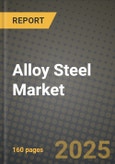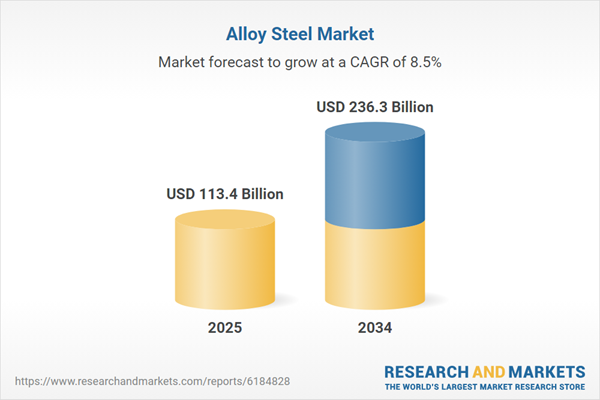Alloy Steel Market
Alloy steel - carbon steel enhanced with elements such as chromium, nickel, molybdenum, vanadium, manganese, and boron - underpins high-performance applications that demand superior strength, toughness, hardenability, wear resistance, and corrosion/heat tolerance. Demand is anchored in automotive (powertrain, chassis, AHSS body structures), industrial machinery (gears, bearings, tool steels), energy and process industries (OCTG, line pipe, pressure vessels), construction and infrastructure (high-strength plate, structural shapes), rail and shipbuilding, and selected aerospace and defense uses. The market’s center of gravity is shifting toward low-alloy and advanced high-strength grades enabling lightweighting, higher fatigue life, and elevated temperature performance. OEMs increasingly specify narrow chemistries and tight tolerance plate/long products, pushing mills to deepen metallurgical expertise, secondary refining, and quality assurance. On the supply side, input volatility for ferroalloys and scrap, decarbonization mandates, and trade measures are reshaping cost curves and regional competitiveness. Producers are accelerating EAF and DRI-based routes, digitalizing melt-shop operations, and expanding clean-steel offerings with certified low-emission footprints. Qualification cycles and multi-year contracts with automotive, energy, rail, and defense buyers raise switching costs and entrench approved supplier lists. Short-to-medium-term catalysts include grid and renewables build-out, pipelines and hydrogen-ready infrastructure, offshore wind, shipbuilding recovery, and tool-steel demand from capital goods. Structural risks remain: cyclicality in construction and autos, overcapacity pockets, shifting trade policies, and tightening environmental rules - tempered by premiumization toward value-added, application-engineered alloys.Alloy Steel Market Key Insights
- Premiumization to application-engineered grades. End-users are migrating from commodity carbon to engineered low-alloy, micro-alloy, and AHSS solutions to meet strength-to-weight, fatigue, and formability targets. This favors mills with secondary metallurgy, vacuum degassing, and inclusion control, and service centers offering heat treatment, machining, and just-in-time kitting to reduce total system cost.
- Automotive transition reshapes product mix. Electrification increases demand for high-strength chassis steels, e-axle gears, and driveline components while reducing some ICE-centric uses. Close collaboration on formability windows, crash performance, and joining is elevating the role of AHSS, press-hardening steels, and bainitic/martensitic grades in body-in-white and safety parts.
- Energy and process industries remain a margin anchor. Sour-service line pipe, high-temperature furnace/boiler grades, and OCTG require strict cleanliness and traceability. Qualification, NDT intensity, and compliance to regional codes create barriers to entry, support long contracts, and stabilize mill utilization across cycles.
- Decarbonization shifts the cost curve. EAF and DRI-based routes, green power PPAs, and scrap optimization are moving from pilots to core operating models. Low-emission certificates and product carbon footprints are becoming RFP line items, allowing price premiums for “green” alloy plate, bar, and tube in infrastructure, mobility, and consumer durables.
- Supply security and nearshoring reshape trade flows. Buyers are diversifying away from single-country exposure, prioritizing approved regional mills and dual-sourcing strategies. Trade remedies, local content rules, and public-procurement preferences drive regional melt-and-pour footprints and encourage investments in heat-treat and finishing close to OEMs.
- Ferroalloy volatility forces agile procurement. Molybdenum, nickel, chromium, and vanadium pricing swings compress margins and complicate quoting. Producers with hedging programs, flexible chemistries, and captive or strategic offtakes maintain service levels and protect spreads, while customers adopt formula pricing and shorter validity windows.
- Digital metallurgy and quality analytics lift yields. Real-time process control, inline surface inspection, and predictive quality reduce scatter in mechanical properties, shorten qualification cycles, and improve first-pass yield. Data-rich mills gain an edge in consistent toughness, through-thickness properties, and weldability for safety-critical parts.
- Service center value creation expands. Downstream processors are investing in quench-and-temper lines, precision sawing, boring, and CNC machining. Bundled logistics, VMI programs, and lot traceability help OEMs cut inventory, compress lead times, and meet audit requirements - making the distribution interface strategically important.
- Standards and compliance tighten globally. Stricter emission norms, product carbon disclosures, and safety codes in pressure vessels, rail, offshore, and construction elevate documentation and test regimes. Mills with multi-standard qualification portfolios and third-party certifications gain access to higher-value tenders and export markets.
- Emerging applications broaden the demand base. Hydrogen transport and storage, offshore wind foundations, heavy-haul rail, and additive manufacturing feedstocks (alloy steel powders) are creating niches with elevated property requirements. Early movers securing specifications and demonstrating lifecycle performance will lock in durable share.
Alloy Steel Market Reginal Analysis
North America
Policy-driven infrastructure renewal, grid modernization, and energy projects support demand for high-strength plate, structural shapes, and OCTG. Reshoring in machinery and transportation equipment benefits alloy bar and tool steels, while automotive electrification accelerates uptake of AHSS and press-hardening grades. EAF capacity additions and scrap-centric operations improve responsiveness and lower embedded emissions. Buy-American provisions and regional content rules favor domestic melt-and-pour with tight qualification and long-term OEM agreements.Europe
Decarbonization is the strategic north star, with hydrogen-DRI pilots, EAF conversions, and green power integration shaping investment. Automotive lightweighting and stringent safety standards sustain premium AHSS and multi-phase steels, while offshore wind, rail modernization, and defense recapitalization add structural demand. CBAM and evolving environmental regulation influence import economics and promote local low-carbon alloys. Energy costs and legacy blast-furnace footprints remain challenges, intensifying the shift to high-value product mixes.Asia-Pacific
The region dominates capacity and spans the spectrum from commodity long products to advanced automotive and energy grades. China’s consolidation and quality upgrades coexist with lingering overcapacity in some segments, influencing export dynamics. India’s infrastructure cycle, rail modernization, and capital goods expansion lift demand for alloy plate, bars, and rails, while Korea and Japan focus on shipbuilding, automotive, and specialty steels. ASEAN industrialization and logistics investments deepen regional consumption and encourage local finishing.Middle East & Africa
Large energy, petrochemical, and desalination projects underpin needs for sour-service pipe, pressure-vessel plate, and specialty bars. Localization agendas and industrial parks are attracting melt-shop and finishing investments, with natural gas and renewables enabling lower-emission routes. Mega infrastructure, rail, and port expansions stimulate structural alloy demand, while project-based procurement and stringent QA/QC favor mills with robust certifications. In Africa, mining, power, and transport corridors gradually broaden the alloy steel addressable base.South & Central America
A resource-rich base supports competitive slab and semi production alongside developing downstream finishing. Offshore developments, particularly in select basins, bolster OCTG and line-pipe requirements, while transportation and urban infrastructure drive structural alloys. Currency swings, logistics constraints, and episodic trade measures shape import parity and pricing. Strategic plays include upgrading to higher-value alloy bars, rails, and plate for domestic machinery, agricultural equipment, and rolling stock, supported by closer OEM-mill collaboration.Alloy Steel Market Segmentation
By Type
- Low Alloy
- High Alloy
- Alloy Steel Product
- Longs
- Flats
By End-User
- Automotive
- Building & Construction
- Energy & Power
- Oil & Gas
- Others
Key Market players
China Baowu Steel Group, ArcelorMittal, Nippon Steel, POSCO, JFE Steel, Tata Steel, JSW Steel, ThyssenKrupp, Voestalpine, Daido Steel, Sanyo Special Steel, TimkenSteel, Swiss Steel Group (Schmolz + Bickenbach), Gerdau, Hyundai SteelAlloy Steel Market Analytics
The report employs rigorous tools, including Porter’s Five Forces, value chain mapping, and scenario-based modelling, to assess supply-demand dynamics. Cross-sector influences from parent, derived, and substitute markets are evaluated to identify risks and opportunities. Trade and pricing analytics provide an up-to-date view of international flows, including leading exporters, importers, and regional price trends.Macroeconomic indicators, policy frameworks such as carbon pricing and energy security strategies, and evolving consumer behaviour are considered in forecasting scenarios. Recent deal flows, partnerships, and technology innovations are incorporated to assess their impact on future market performance.
Alloy Steel Market Competitive Intelligence
The competitive landscape is mapped through proprietary frameworks, profiling leading companies with details on business models, product portfolios, financial performance, and strategic initiatives. Key developments such as mergers & acquisitions, technology collaborations, investment inflows, and regional expansions are analyzed for their competitive impact. The report also identifies emerging players and innovative startups contributing to market disruption.Regional insights highlight the most promising investment destinations, regulatory landscapes, and evolving partnerships across energy and industrial corridors.
Countries Covered
- North America - Alloy Steel market data and outlook to 2034
- United States
- Canada
- Mexico
- Europe - Alloy Steel market data and outlook to 2034
- Germany
- United Kingdom
- France
- Italy
- Spain
- BeNeLux
- Russia
- Sweden
- Asia-Pacific - Alloy Steel market data and outlook to 2034
- China
- Japan
- India
- South Korea
- Australia
- Indonesia
- Malaysia
- Vietnam
- Middle East and Africa - Alloy Steel market data and outlook to 2034
- Saudi Arabia
- South Africa
- Iran
- UAE
- Egypt
- South and Central America - Alloy Steel market data and outlook to 2034
- Brazil
- Argentina
- Chile
- Peru
Research Methodology
This study combines primary inputs from industry experts across the Alloy Steel value chain with secondary data from associations, government publications, trade databases, and company disclosures. Proprietary modeling techniques, including data triangulation, statistical correlation, and scenario planning, are applied to deliver reliable market sizing and forecasting.Key Questions Addressed
- What is the current and forecast market size of the Alloy Steel industry at global, regional, and country levels?
- Which types, applications, and technologies present the highest growth potential?
- How are supply chains adapting to geopolitical and economic shocks?
- What role do policy frameworks, trade flows, and sustainability targets play in shaping demand?
- Who are the leading players, and how are their strategies evolving in the face of global uncertainty?
- Which regional “hotspots” and customer segments will outpace the market, and what go-to-market and partnership models best support entry and expansion?
- Where are the most investable opportunities - across technology roadmaps, sustainability-linked innovation, and M&A - and what is the best segment to invest over the next 3-5 years?
Your Key Takeaways from the Alloy Steel Market Report
- Global Alloy Steel market size and growth projections (CAGR), 2024-2034
- Impact of Russia-Ukraine, Israel-Palestine, and Hamas conflicts on Alloy Steel trade, costs, and supply chains
- Alloy Steel market size, share, and outlook across 5 regions and 27 countries, 2023-2034
- Alloy Steel market size, CAGR, and market share of key products, applications, and end-user verticals, 2023-2034
- Short- and long-term Alloy Steel market trends, drivers, restraints, and opportunities
- Porter’s Five Forces analysis, technological developments, and Alloy Steel supply chain analysis
- Alloy Steel trade analysis, Alloy Steel market price analysis, and Alloy Steel supply/demand dynamics
- Profiles of 5 leading companies - overview, key strategies, financials, and products
- Latest Alloy Steel market news and developments
Additional Support
With the purchase of this report, you will receive:- An updated PDF report and an MS Excel data workbook containing all market tables and figures for easy analysis.
- 7-day post-sale analyst support for clarifications and in-scope supplementary data, ensuring the deliverable aligns precisely with your requirements.
- Complimentary report update to incorporate the latest available data and the impact of recent market developments.
This product will be delivered within 1-3 business days.
Table of Contents
Companies Mentioned
- China Baowu Steel Group
- ArcelorMittal
- Nippon Steel
- POSCO
- JFE Steel
- Tata Steel
- JSW Steel
- ThyssenKrupp
- Voestalpine
- Daido Steel
- Sanyo Special Steel
- TimkenSteel
- Swiss Steel Group (Schmolz + Bickenbach)
- Gerdau
- Hyundai Steel
Table Information
| Report Attribute | Details |
|---|---|
| No. of Pages | 160 |
| Published | November 2025 |
| Forecast Period | 2025 - 2034 |
| Estimated Market Value ( USD | $ 113.4 Billion |
| Forecasted Market Value ( USD | $ 236.3 Billion |
| Compound Annual Growth Rate | 8.5% |
| Regions Covered | Global |
| No. of Companies Mentioned | 15 |









